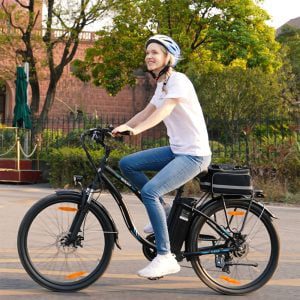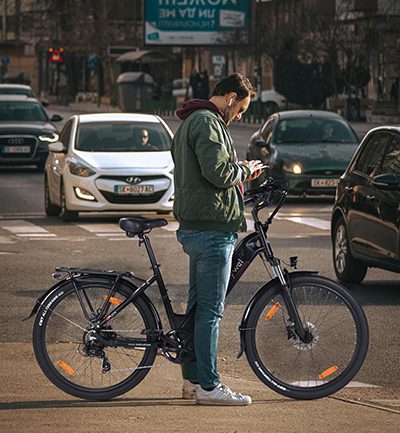Cycling extends beyond riding fast and long distances. It’s also about keeping oneself in peak physical shape. Tough people can get pedal assist ebikes from different ebike companies, technique to hold those leg muscles lean and to recover muscles after the ride is crucial for enthusiasts, regardless of the ebike brand. This article gives off the essence of the importance of hydration, proper cycling posture, gear shift, and recovery techniques not only for the prevention of muscle bulkiness but for overall good cycling performance.
1. Hydration: Cornerstone of Muscle Recovery
Proper hydration is paramount in optimizing physiological functions and improving circulation, which helps deliver nutrients and remove waste, especially during very long or intense exercises. Below are the detailed steps and reasons on how to maintain hydration.
– Hydration Before Cycling
Pre-ride hydration ensures that the body is well hydrated from the start, hence avoiding dehydration that has a pull-down effect on performance. In addition to this, dehydration increases blood viscosity, and the more viscous the blood, the more the load on the heart: in simple terms, this will lower performance. Take in 500-600 milliliters of water 30 to 60 minutes before cycling. Room temperature water is recommended for better absorption by the body.
– Hydration While Cycling
This continuous physical activity, cooled by sweat, leads to large losses of water and electrolytes. Therefore, it is important that one takes water timely to be able to maintain body temperature, muscle function, and prevent dehydration. It is usually said that a sip of water per 10-15 minutes should be taken, but it is definitely necessary to modify this according to the weather conditions, personal sweat rate, and fluid intake. Just like anything, though, if it’s really hot or you’re having a hard ride, do it more often and be a bit more liberal with how much you ingest. The water bottle or hydrant pack is convenient to use during a ride.
– Hydration After Cycling
Post-ride hydration quickly replaces water and electrolytes lost during exercise. Doing so helps in muscle recovery, relieving fatigue and stiffness, and accelerating lactic acid and other metabolic waste recovery.
Drink at least 500 ml of plain water immediately, thereby initiating replacement of fluid lost and restoration of fluid balance in the body. In rides longer than one hour, athletes should switch to a sports drink for replacing the electrolytes lost from the body: sodium and potassium are the main electrolytes lost and are important support electrolytes in maintaining normal muscle and nerve functions.
2.Correct Cycling Posture: Efficient and Safe Riding
Except the essential ebike helmet, the bike setup may be adjusted for greater comfort and efficiency by ensuring proper cycling position, which will also minimize the possibility of injury. These operational details are crucial both for beginners and experienced cyclists.
Adjust ebike seat height and handlebar height especially you purchase ebike 2nd hand. Of course, you’ll need to learn that too when you buy a brand new ebike. The correct seat height allows the cyclist to maintain a proper range of motion in their legs, not putting unnecessary pressure on the knees yet still achieving an effective power transmission to the pedals. Handlebar height alters the posture of the upper body such that an appropriate height reduces stressful posturing of shoulders, necks, and back. The cyclist should pedal with the heel down—instep—with his or her foot on the pedal in its lowest position or starting position. Extension of the knee should occur to full extension. If you have bend in your knee, the seat is too low. You know the seat is too high if the hips have to shift to hit the pedals.
The height of the handlebars should be in a position where the cyclist can lean slightly forward with his or her back in a natural, upright position. Too high handlebars relate to low control, and too low too much pressure on the lower back and neck.
Pedal Position This guarantees the right placement of pedals, facilitates an improved control of the pedals, raises efficiency on the pedals, and reduces strain on the ankles and knees. Now, place the middle to the front of the foot directly above the pedal axle. This shares the overall pedaling exertion at a spot that is fairly consistent with the foot, thereby improving comfort and ride quality. Pedaling with the toes, meanwhile, creates higher strain on the ankles, hence accrued exposure to many long-term injuries.
With these changes, a cyclist maintains a natural, efficient riding posture that combats fatigue and ailments caused by improper posture and, at the same time, permits comfortable, prolonged cycling. Proper cycling posture will also, therefore, increase a cyclist’s participation in cycling in terms of long durations of riding or competition.
3.Cadence and Gear Shifting: Muscle Use Optimisation
Light gear ratios and a high rate of pedaling allow cyclists to considerably enhance pedaling efficiency, decrease muscle fatigue, and improve blood circulation. With improved endurance, especially during long rides, a cyclist has a chance to sustain lower muscle strain.
– Practicing High Cadence
Such a high cadence as 90 to 100 revolutions per minute reduces the magnitude of force a muscle has to put to work during each revolution of the pedals, hence reducing muscle stress and fatigue. An increased rate also serves to boost blood flow for providing more oxygen and nutrients to the muscles while the removal of metabolic waste products is increased simultaneously. Begin on flat terrain to gradually get accustomed to a higher cadence. If possible, use a pedometer or bicycle computer to monitor your cadence to ensure you reach the target range. Consistent Practice: Regularly practice riding at high cadence to turn it into a habit. It might feel unnatural or difficult at first, but it will become easier over time.
– Gear Shifting
Properly adjusting gears according to different road conditions helps cyclists maintain a steady cadence, thereby avoiding excessive force in too high a gear. This not only reduces muscle load but also prevents premature fatigue.
Familiarize yourself with your bicycle’s gearing system and understand the feel and appropriate scenarios for different gears. Adjust Gears According to Terrain. Shift to a lower gear before ascending to keep the cadence consistent; increase the gear when descending to use gravity to your advantage and reduce pedaling frequency. Continuously adjust gears during your ride based on road conditions and how you feel to avoid riding in inappropriate gears for extended periods.
By employing these practices and techniques, cyclists can more effectively control their riding pace and effort, enhancing comfort and efficiency on long rides. This not only helps improve cycling performance but also significantly reduces the risk of injuries, especially in scenarios requiring prolonged or intense cycling efforts.
4. Stretching and Relaxation Techniques: Recovering Faster
The proper stretches and the use of a foam roller lie within retrieving flexibility to the muscle, relieving it from tension and fatigue, and preventing cramping and muscle injury. These detailed stretching and relaxation techniques will effectively help cyclists release muscle tension and fatigue after a long ride, thus increasing the rate of recovery to retain the healthiness and functionality of the muscles.
Quadriceps Stretch: Cycling is a mono-dimensional exercise, with the quadriceps at the front of thigh mainly used, so stretching does much to relieve tension and stiffness. Stand up and bend one knee, locking onto the ankle of the same limb and pulling the heel toward buttocks until stretch is felt in front of thigh. Hold your balance and repeat 20-30 seconds on either side for 2-3 sets.
Hamstring Stretch:
The hamstrings also generate significant force during cycling, and proper stretching can prevent injuries caused by tension.
Seated on the ground, with one leg fully extended and the other bent open, reach towards your toe-foot on the extended leg to where you begin to feel light resistance in the target muscle, keeping the back/sternum as upright as possible. Hold each side for 20-30s for 2-3.
Hip Flexor Stretch
Gluteal: Working very hard when cycling, the gluteal muscles receive a significant amount of strain, and, therefore, stretching at this point helps in allowing relaxation and recovery. Lie on the floor and extend one of your legs; alternatively, you can cross one leg over the knee of the other leg. Use your chest to try and push towards the crossed leg to feel a stretch in the gluteal muscles. Hold each side for 20-30 seconds for 2-3 sets.
5.Cross-Training: Balanced Muscle
It is an important part of training strategies: cross-training that gives exposure to different physical activities and further also raises the balance and flexibility of muscles in one’s body. It prevents injuries in the particular sport due to repetitive movements. Perhaps the biggest benefit from engaging in other sports includes the sports of swimming, yoga, and strength training for cyclists. Each has its benefit.
Swim, do yoga, and train for strength: One weekly routine might include these activities. Swimming provides all-round exercise without the stress on the legs; yoga works flexibilities and core strengths related to critical cycling posture, and strength training enhances muscle power and endurance.
By adopting these practical cycling tips and techniques, cyclists will not only be able to improve the comfort and efficiency of their rides, but also optimise physical recovery and muscle maintenance. These strategies ensure that cyclists can make their ebike the best value ebike, enjoy their rides while also keeping their bodies in tip-top shape. Whether you are an amateur or a professional cyclist, it is important to focus on these basic health and safety measures for long-term sport sustainability and improved performance. Remember, cycling is an activity that provides both physical benefits and mental pleasure, and the right techniques and training methods can make the sport safer and more rewarding. Using a combination of these tips and techniques will help every cyclist reach their cycling goals, whether they are looking for speed, distance or simply fitness fun.




